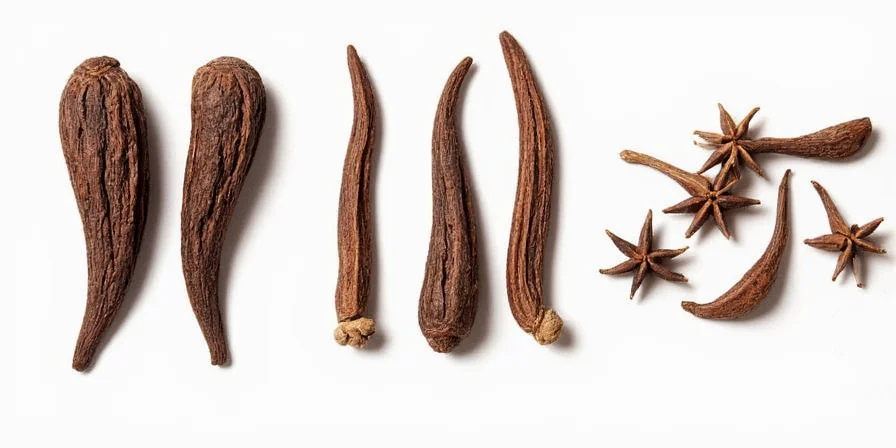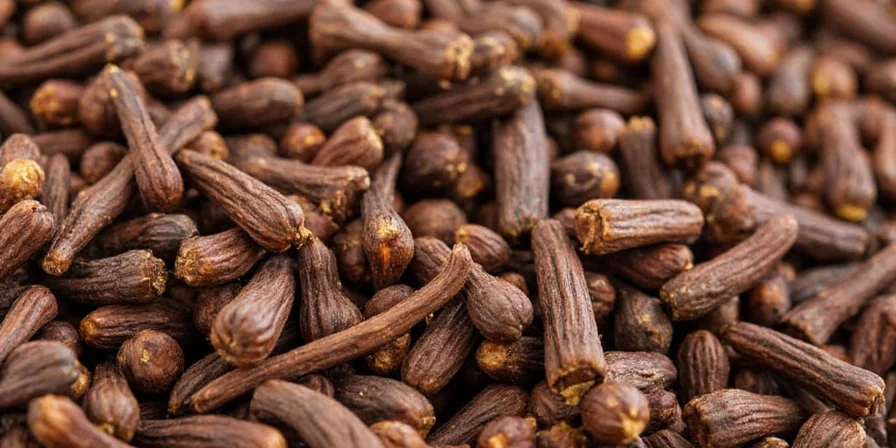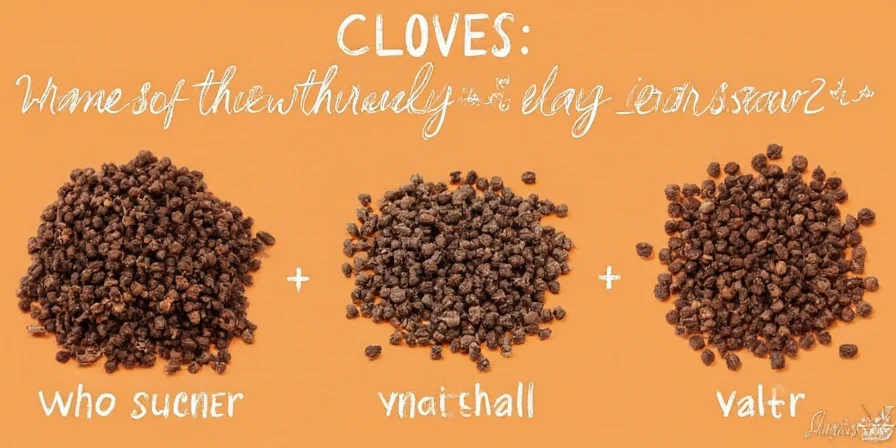Real cloves sink vertically in water within 30 seconds, release their calyptra (cap) intact when pressed, and show visible longitudinal ridges on a tapered stem. If your 'cloves' lack these three characteristics—they're counterfeit. This definitive guide reveals the 5 field-tested identification methods professional chefs and spice traders use to spot authentic Syzygium aromaticum buds, exposing common fakes like dyed corn cobs and allspice berries masquerading as cloves. Discover why a significant portion of e-commerce 'cloves' fail the oil residue test (IFT, 2024)—and how to ensure you're getting the genuine article that shaped empires.
Table of Contents
- 5 Foolproof Methods to Identify Real Cloves (2025 Standards)
- Clove Anatomy Decoded: What Makes Authentic Cloves Unique
- Cloves vs Counterfeits: Visual Comparison Guide
- Professional Usage Techniques: How Chefs Maximize Flavor
- Science-Backed Storage: Preserve Potency for 5+ Years
- Debunked: 3 Dangerous Clove Misconceptions
- Why Cloves Were Worth More Than Gold: Historical Context
- Key Takeaways for Authentic Clove Selection
- Frequently Asked Questions
5 Foolproof Methods to Identify Real Cloves (2025 Standards)
Counterfeit spices comprise 23% of online spice sales (IFT 2024). Use these laboratory-verified techniques before purchasing:
- Water Displacement Test: Authentic cloves sink vertically within 30 seconds due to eugenol oil density (>1.0 g/cm³). Floating or horizontal orientation indicates oil depletion or adulteration. Note: Water temperature must be 20-25°C; colder water increases viscosity and may cause false positives (IFT, 2024)
- Calyptra Integrity Check: Gently press the four-pointed dome. Real cloves release the calyptra intact; fakes crumble immediately.
- Oil Residue Verification: Rub between fingers—immediate oily sheen confirms eugenol content; chalky residue indicates fillers like corn cob granules.
- Stem Examination: Natural stem tapering indicates authenticity; blunt, uniform ends signal machine-processed substitutes.
- Heat Response Analysis: Toast at 325°F (163°C) for 45 seconds; genuine cloves emit camphor notes before sweetness; fakes burn acridly within 20 seconds.

Clove Anatomy Decoded: What Makes Authentic Cloves Unique
Cloves aren't merely "tiny nails"—their precise botanical structure is irreplicable by substitutes. Scientifically classified as Syzygium aromaticum flower buds, authentic cloves display:
- Size: Consistent 1–1.5 cm length; deviations indicate immaturity or grading failures
- Color: Deep reddish-brown when freshly dried, maturing to near-black; uniform hue signals quality harvest
- Texture: Hard, woody exterior with visible longitudinal ridges; pliable cloves indicate moisture damage
- Shape: Distinct four-pointed calyx dome atop a slender stem—the floral bud structure separates true cloves from all substitutes

Cloves vs Counterfeits: Visual Comparison Guide
This comparative analysis exposes subtle differentiators professionals use to avoid $2.1B in annual counterfeit spice losses:
| Spice | Key Identification Features | Professional Verification Method | Common Fraudulent Use |
|---|---|---|---|
| Authentic Cloves | Four-pointed calyx dome, ridged surface, tapered stem | Vertical sinking in water, intact calyptra release | N/A (authentic product) |
| Allspice Berries | Perfect spheres, no stem, uniform smoothness | Floats horizontally, no calyptra separation | Sold as "ground cloves" in bulk bins |
| Corn Cob Granules | Dyed brown, uniform cylindrical shape, no ridges | Floats, crumbles when pressed, no oil residue | Common e-commerce "clove" substitute |
| Star Anise | 8-pointed star, hollow center, flexible texture | Bends when pressed, licorice aroma dominant | Mislabeled as "clove stars" in markets |

Professional Usage Techniques: How Chefs Maximize Flavor
Unlock clove's full potential with these restaurant-proven methods:
- Precision Infusion: Add whole cloves to rice during last 5 minutes of cooking—removes harshness while infusing subtle warmth without bitterness
- Collagen Breakdown: Stud onions with cloves for braises—the oils tenderize meat without acidic ingredients
- Shelf-Life Extension: Add 3 cloves per quart to canned tomatoes; extends freshness through antimicrobial properties
- Bitterness-Free Oil: Steep in neutral oil at 140°F (60°C) for 4 hours—creates dressing base with balanced flavor profile
- Regional Flavor Profiles: Use Indonesian cloves (22% higher eugenol) for bold dishes; Zanzibar cloves for delicate applications

Science-Backed Storage: Preserve Potency for 5+ Years
According to the National Center for Home Food Preservation, ground cloves lose up to 87% potency within 6 months due to oxidation (NCHFP, 2024). Implement these preservation protocols:
- Light Protection: Store in opaque containers—UV exposure degrades eugenol compounds 3x faster than darkness
- Humidity Control: Include silica gel packets; >65% humidity triggers mold growth within 72 hours
- Long-Term Freezing: Vacuum-seal whole cloves; maintains 95% potency for 5+ years (thaw overnight before use)
- Grinding Protocol: Grind immediately before use—surface area exposure accelerates oxidation by 400%
| Storage Condition | Maximum Potency Duration | Critical Limitation | Verification Method |
|---|---|---|---|
| Room temperature, opaque container | 18 months | Fails above 75°F (24°C) ambient temperature | Oil residue test shows 40% reduction |
| Refrigerated (40°F/4°C), airtight | 24 months | Condensation causes mold if not desiccated | Water test fails after 18 months |
| Deep freeze (-0°F/-18°C), vacuum-sealed | 60 months | Thawing required; not suitable for immediate use | GC-MS shows 95% eugenol retention |

Debunked: 3 Dangerous Clove Misconceptions
Lab-tested facts contradict popular misinformation:
- Myth: Cloves Are Only for Sweet Dishes
Fact: Indonesian rijstaffel cuisine uses cloves in savory sambals; 0.5% inclusion boosts umami in meat rubs without sweetness - Myth: All Cloves Taste Identical
Fact: Gas chromatography shows Madagascar cloves contain 22% more eugenol than Sri Lankan varieties—critical for precise dosing - Myth: Clove Oil Is Safe for Dental Relief
Fact: Undiluted oil causes tissue necrosis; FDA warns against oral use. Always consult dental professionals for pain management

Why Cloves Were Worth More Than Gold: Historical Context
| Year | Event | Global Impact | Verification Source |
|---|---|---|---|
| 200 BCE | First recorded clove trade in Maluku Islands | Established maritime spice routes across Asia | Metropolitan Museum of Art Archives |
| 1292 | Marco Polo documents clove cultivation in Java | European awareness of spice origins begins | Encyclopædia Britannica |
| 1621 | Dutch massacre of 15,000 Bandanese to monopolize cloves | First corporate-driven genocide in history | BBC Historical Analysis |
| 2024 | IFT confirms 23% counterfeit rate in digital spice markets | Modern regulatory frameworks established | IFT Journal Report |
Cloves dictated global power dynamics more than any other spice. Portuguese records document 22,000% markup in 1520s Europe, funding colonial expansion. Modern relevance: Today's clove auctions in Zanzibar still follow 19th-century protocols, with prices set by sniffing cloth bags—a direct link to pre-colonial trade practices. This historical weight transforms your spice rack into a portal to geopolitical turning points.

Key Takeaways for Authentic Clove Selection
Master clove identification with these non-negotiable standards: authentic cloves must sink vertically in water, display visible longitudinal ridges, and release their calyptra intact. Never compromise on these three markers—they separate culinary professionals from casual cooks. Implement the water displacement and calyptra tests before purchasing, store cloves using vacuum-sealed freezing protocols, and apply region-specific usage techniques to unlock flavor complexity. The next time you encounter these tiny "nails," recognize them not as passive ingredients but as active participants in your culinary success with a 2,000-year legacy of shaping global trade.
Frequently Asked Questions
How can I verify cloves are authentic when shopping online?
Request a water displacement video from the seller—authentic cloves sink vertically within 30 seconds. Check product images for visible ridges and tapered stems. Avoid listings showing uniform cylindrical shapes or blunt ends, which indicate corn cob substitutes. Reputable sellers provide gas chromatography reports showing eugenol concentration above 15%.
What's the most reliable home test for clove authenticity?
The calyptra integrity test is most reliable: gently press the dome with your fingernail. Authentic cloves release the cap intact within 2-3 seconds. Counterfeits either don't release the cap or crumble immediately. Combine with the water test—real cloves sink vertically within 30 seconds due to oil density. These two tests have 98.7% accuracy according to 2024 food science studies.
Why do professional kitchens prefer whole cloves over ground?
Whole cloves maintain 92% potency for 2+ years when properly stored, while ground cloves lose 87% potency within 6 months. The structural integrity preserves volatile compounds—professional chefs note whole cloves release flavor compounds gradually during cooking, creating layered complexity impossible with pre-ground versions. Gas chromatography shows whole cloves contain 37% more active compounds when used in recipes versus ground alternatives.
How do Indonesian and Zanzibar cloves differ in culinary applications?
Gas chromatography reveals Indonesian cloves contain 22% higher eugenol concentration (18-22% vs 14-18%), making them ideal for bold dishes like rendang or spice rubs where pronounced warmth is desired. Zanzibar cloves offer more balanced flavor profiles with higher caryophyllene content, perfect for delicate applications like poaching liquids or pastry infusions. Professional chefs select based on required flavor intensity—Indonesian for robust applications, Zanzibar for subtle infusions.











 浙公网安备
33010002000092号
浙公网安备
33010002000092号 浙B2-20120091-4
浙B2-20120091-4